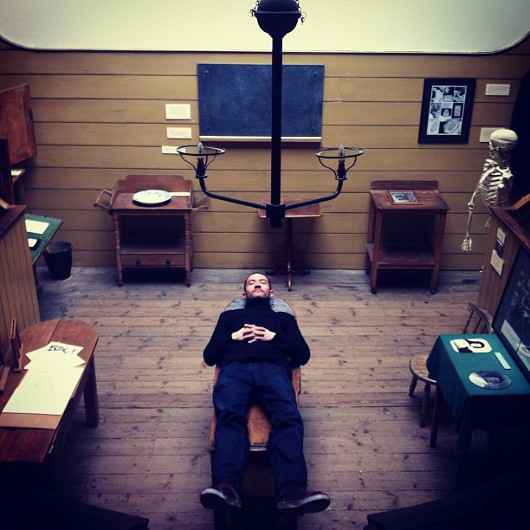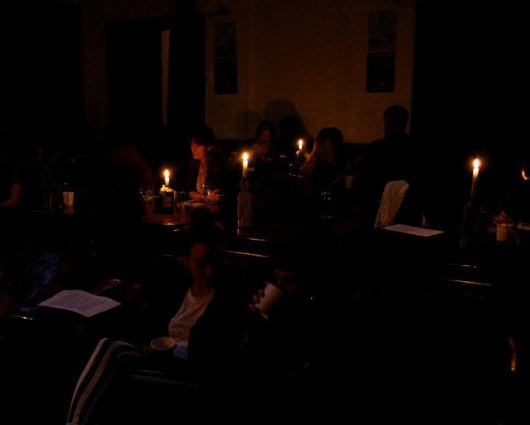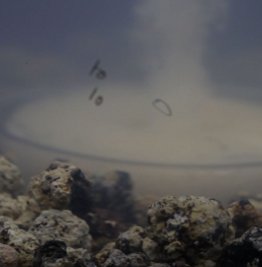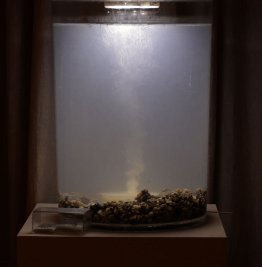Surgical scrubs, focus groups and the indescribable lure of London: An interview with Chairman Kato

It’s a typically wet East London evening in late June, and I am draped in oversized stolen surgical scrubs, making my music video debut as the disinterested lab assistant to a Glaswegian teashop proprietor and budding medical torturer who has drugged and is subsequently planning to inject a nasty-looking potion into the man lying on a table in front of me.
Welcome to the world of Chairman Kato.
Across a handful of releases for the Pictures Music and Awkward Movements labels, Kato has swiftly established a somewhat claustrophobic, fuzzy take on electronic music that’s accompanied by his eccentric, individual and somewhat mysterious personality. Press releases divulge a fondness for Gaviscon and pancetta omelettes, while his online presence paints a picture of a sharp but affable mind who likes to play on the art of the stupid genre name when quizzed on his own musical style. This impression was only strengthened when Kato arrived at the Rhythm Factory to DJ alongside the Juno Plus team at an Oscillate Wildly event earlier this year with some bags of Haribo as gifts. With some artists or musicians this sort of behaviour might seem contrived or “wacky” but with Kato it all forms part of a genuinely intriguing individual seemingly driven by boundless creative urges.
My participation in the somewhat bizarre circumstances unfolding in the basement of The Teasmith as described above is happening despite the fact we’ve crossed paths only a smattering of times. As regular users of Twitter we frequently engage in the kinds of throwaway topics that 140 characters limit you to, but otherwise, aside from the night at The Rhythm Factory mentioned above, we had only met a couple of times. It was one of those occasions, during a Juno Plus night at the XO Bar, that I drunkenly agreed to participate in a forthcoming film shoot, and the exact details began to lose their hazy edge via email correspondence in advance of the evening (one notable example read: “I have obtained surgical scrubs and a stethoscope for you sir. You thought this was a joke son? This ain’t no joke.”)
So there I am, standing barefoot in the basement (lab assistants don’t really rock brogues on surgical duty do they?) flanked by Kato’s chief tormentor John, a softly spoken Scotsman wearing a slightly-too-tight black hoody with requisite menace, towering over our relaxed subject replete with his apparent trademark panda hat reclining on a tea table. We spend over six hours that night filming footage for what will become the video accompaniment for the brashly titled “Fuck This”, a track from the producer’s forthcoming release, due out in October on the Shades Of Grey label. Rob McDougall, a graphic designer, budding video director and, as you will learn, a regular collaborator with Kato, is in charge of turning those six hours into the final product and it would be inconsiderate to fully divulge how the video unfolds in advance of the finished product arriving, though it was perhaps the most bizarre Saturday I’ve had in recent times.
Fast forward several weeks, and it’s a Sunday evening in the disappointing aftermath of the ill-fated Bloc festival and now I am one of nearly thirty people sat in the darkened back room of Dalston pub The Duke of Wellington. The occasion? We’re attending The Focus Group, an evening of communal listening set up by Chairman Kato, who had several weeks prior surreptitiously invited seven unspecified individuals to submit three tracks along with a description detailing the choices behind each. This writer was among those chosen, while others turned out to include my fellow participants in that video shoot, along with Ruth Saxelby of Dummy, the musician Blue Daisy, a rising photographer in Meg Sharp and Josh A Hall, writer for The Quietus and The Line Of Best Fit.
In the lead up to the event it was unclear exactly how the evening would pan out; would there be discussion of each track and people’s reactions to it? In the end the subsequent two hours plus proved to be a neat play on words of the title, as attendees sat in silence, left unencumbered to concentrate on the diverse range of music that unfolded. Programmes including our written choices for the evening’s soundtrack along with amusing descriptions of each contributer penned by Kato are circulated, with some soothing tea on offer as we take our seats, purposefully arranged to point directly forwards at the fireplace. Candles burn atop and as the music commences, a silence descends and we get lost in those burning flames.
Underbelly from Rob McDougall on Vimeo.
The remit for musical freedom is fully adhered to, with some submissions challenging and others soothing. Classical pieces loaded with political meaning from Shostakovich sit next to Carl Craig remixes, Creative Sources melds into The Cure, The Prodigy blast out next to Outfit. Blue Daisy in particular provided the most challenging selections, with tracks from Ben Frost, The Caretaker and Murcof providing some insight into the inspiration for his own unique sounds. Given the communal feeling of being together and sharing in a collective experience it’s little surprise that spontaneous applause breaks out as each of the two sessions finishes.
The reasons for Kato hosting this event are paramount in my thoughts as we reconvene a week or so later to discuss his music and more at the open plan living room of his home/studio, a flat with a vista-like view of East London in a converted synagogue in the residential backstreets between Dalston and Hackney Downs. Displaying his typical mix of humour and thoughtful discourse, it transpires the idea for the Focus Group first came from “the borderline autistic thing that guys in music share” – an insatiable hunger for new musical stimuli. As he puts it: “I was thinking wouldn’t it be really good if I could go round to a bunch of people’s houses and raid their record collections, just find out about new stuff the lazy way, and then I thought, why not just get them to come down to the pub and broaden my horizons that way.”
While that might seem self serving, don’t worry, he’s only joking – the Focus Group was framed as a riposte to the solitary endeavour of musical engagement: “I thought, when do you really get to sit and enjoy music with other people? It’s quite rare – for some reason music is quite a solitary thing. When I’m making it I’m by myself most of the time and when I listen to it I’m by myself, I’ve got my headphones on when I’m on the tube or whatever.”
The shared feeling of enjoyment that resulted in spontaneous applause that night continued as the participants took to Twitter to discuss the selections and generally express how unique it felt to participate. For the organiser himself, that was more than just rewards for putting the event on as he rather sweetly divulges “it feels like a really nice thing to have done, a really simple and uncomplicated experience of musical enjoyment”. Kato has elected to open the night’s music for wider appreciation, making all the tracks available to stream on Mixcloud and while you will no doubt find it interesting to veer through the 24 track, two hour selection, the impact might not be as strong sat alone listening on your laptop. Luckily Kato plans further events later this year, while ambitiously stating at one point he’d like to take over a cinema theatre to do a Focus Group on large scale using visuals to increase the immersive feeling. Our discussion that evening reveals a penchant for ambitious ideas that feeds off his own desire to broaden his creative horizons, which is in turn inspired on a daily basis by that most maligned of subjects: London Town.
In the current climate where people seem fed up with London life, a feeling no doubt magnified by the supposed legacy of the 2012 Olympics, Kato is effusive in his enduring love of everything the city has to offer. This refreshing lack of cynicism is no doubt partly informed by the fact he’s only been living in London for three years, having previously grown up in Leeds, but the range of ways he’s invested his creative urges since he made the move makes you think it will be a long while before that cynicism does set in. Music, or specifically the desire to make it, was the motivating factor to swap Leeds for London, having developed the urge via the familiar path; firstly, spending his teenage years “in crap bands that ripped off the Smashing Pumpkins or whatever” then moving on to DJing and promoting club nights in Leeds.

From collecting vinyl, ideas for his own music formed in Kato’s head from being exposed to artists as diverse as Tejada and Mayer to Dilla and the Stones Throw crew, whose “lack of regard for prosaic concerns like structure” particularly appealed to Kato. When asked why he felt he needed to trade West Yorkshire for London, Kato pauses momentarily to compose his thoughts, before stating that “Leeds is great but I just needed to leave. You don’t have stuff like the Tate Modern on your doorstep. I felt culturally I was a bit starved up there and really was dying to come down. And to be honest the novelty still hasn’t worn off, maybe because I felt like that I was up there a little bit too long it’s actually made me really appreciate London like I still have the same energy to go and find new things that I did when I moved down”.
Indeed this energy has seen him experiment with more than music, and has been channelled into art installations, running a website based around interviewing his creative influences and making films, all of which he freely admits would have been inconceivable before moving to London. He says “seeing examples of people doing stuff who have no right to be doing it, people without training to do “activity x” and yet they’re really, really good” gave him the confidence to explore his own creative urges. Music has remained his primary engagement – “it’s the medium I feel I have the grasp of most” – as he puts it, but he credits “the mass of inspiration that London’s given me” with exploring other avenues. A recent fortnight long trip to San Francisco seemingly highlighted how much of a creative hold London has on him, saying that amid all the West Coast relaxation he would have found it impossible to sit down and write some music. “Although I didn’t want to come back home as I was having such a great time, I kind of felt like I understood my place. I felt like London for all its sins is somewhere that I have my place and I understand my environment really well, and I channel that into my creativity.”
In response to quizzing Kato on the art installations he’s completed thus far, he offers a demonstration of the second to my face, while explaining the first. Naturally I agree. So after he leads me over to his computer to play the promo video for the first, Underbelly, he escapes his living room to get the props that went into his next. Underbelly was an audio visual installation done in collaboration with spatial animator Chris Stoneman that took place in May 2011 in the very same Teasmith basement that we filmed his music video. Wrapping the walls and floor of the basement in industrial polythene, the low lit installation invited attendees to enter barefoot, whereupon Stoneman’s animation would spring to life soundtracked by a three part five minute composition from Kato that would play on loop. The installation was described in advance as “a site-specific installation in the heart of Spitalfields, both a reaction to and a reaction against the teahouse under which it lives,” while a returning Kato, now brandishing some rolled up material and scissors, adds it “was really dark and kind of immersive”. He proudly says “it’s one of the best things I’ve ever done – it was so enjoyable and stressful, but a good kind of stress.”
So onto his next art piece, which was part of a group exhibition he himself put on, a decision he brands “quite stupid” with typical self effacement, prefacing his description with the revelation he only just finished his involvement on time. “I basically just hit up a number of people who I really rated – artists, photographers, whatever – and said look, I’ve got this space and I want to put on a group art show and invited them down. There were nine of us altogether and I just thought it was my first opportunity to do a purely visual piece of art with no help, just my own thing.” For his own piece, he spent six weeks approaching people he knew and strangers in bars, restaurants, cafes and on the streets with a pad of post-it notes, asking them to write down “something they’ve always wanted to do but never got round to, like an unfulfilled aspiration.” He collected these in total anonymity, never asking what was written in order to be an objective facilitator. He hands me pages of paper with all those scrawled personal regrets scanned onto them; themes vary from laments over not learning languages and never travelling to those destinations of your dreams to more personal regrets concerning parents and relationships, and Kato quite rightly admits to being “quite touched that people had entrusted me with that information”.


All of these hundreds of written anonymous confessions, written in some fifteen languages, were scanned into a computer, printed onto film and cut up and placed into a fish tank which was then filled with hot water, causing the film to dissolve and making the characters break apart and mix together. Entitled Purgatory, it “became this concoction of people’s aspirations that were unfulfilled”, and despite people asking him to reveal the meaning behind it, Kato preferred to say nothing, explain that “being from a musical background I think you shouldn’t tell people the meaning of songs, they should make up their own and I feel the same about art.”. His miniature demonstration for this writer that day consisted of four unfulfilled aspirations being placed in a small jar filled with boiling water from a kettle, a rather concise way of showing his art, and something he’s subsequently decided to explore further, telling me he plans to present further miniature purgatories as business cards at art galleries, while also vaguely revealing his plans to expand on the themes of Underbelly which involve the consultation of an architect.
Directing the conversation back to his music, I ask that question every musician dreads – what or who influences you musically – and to his credit, Kato delivers an answer worthy of a much less risible line of inquiry, stating that he’s inspired by those who command “a strong aesthetic or a solid vision”, citing everyone from Actress and Martin Hannett to Ridley Scott and the painter Bridget Reilly. “There’s something about that completeness of a vision and they’re taking you somewhere else that I really, really get.” Actress seems to particularly resonate with Kato, a musician he approached and successfully interviewed (in his kitchen of all places) as part of the Work Ethic site established after the move to London in order to detail and explore the stories behind those with a creative vision he admired. Much like the idea behind The Focus Group, the website was set up with the notion that “it would be cool to go round to people’s houses and ask how they came to be where they are”.
The site is no longer updated but remains active and is a nice online footnote in Kato’s ongoing creative journey which sees his third release arrive in a few months. Curious to learn more about that music video for the release in which I cameo, it’s little surprise that the idea for it was entirely down to Kato himself. Asked if the corrugated, crunching sounds of “Fuck This” were in any way an influence for the concept of the film, Kato says the idea was more a reflection of his interests. “It’s just putting all the elements together. I hang out in Teasmith all the time. I like stuff that’s dark and strange.” He also seems eminently happy with the results, stating “it was great, such good fun, I love that feeling of a bunch of people giving up their time to do something really silly. It was genuinely enjoyable.” He goes on to describe Rob McDougall as his visual director, in charge of both the artwork and video for the forthcoming release, a deliberate plan to present Shades Of Grey with something more than just a bunch of mp3s. The two have been working together for a while now – it was McDougall who composed the short video to accompany the Underbelly installation – and they seem like a good team, as Kato explains: “We’ve just got a lot of similar interests and stuff and if I ‘m stumped on something creatively I’ll talk to him about it and often he’ll help me work it out.”
McDougall was indirectly responsible for lifting Kato out of the creative black hole that prevented the completion of the Roma EP, with Kato stumped on ways to finish the final track for some six months. Staring at a creative brick wall, the two took the unusual choice of sitting through all four Alien films in one night at the Prince Charles Cinema. “I was dreading it before hand, it felt like a stupid idea, I thought we’d fall asleep or it would be really boring, but we stayed awake the whole time from 6pm until 3 in the morning. And weirdly, after we came out I just said, “yeah I know what to do now” and went home and wrote “Yeah You’re Right Pts 1 & 2” and that was it, it was done.”
We end our conversation speculating about what the future might bring for Kato, and the intriguing revelation of plans to establish his own record label along with his trusty visual director surfaces, with the duo’s creative work put into the release of the forthcoming Roma EP pitched as a dry run for how they want to approach this prospective new endeavour. In amidst this expect to see more films, grandiose art installations and whatever else London deems to inspire in him.
Words: Tony Poland
Photos: Meg Sharp (The Focus Group), Rob McDougall (Purgatory shots)